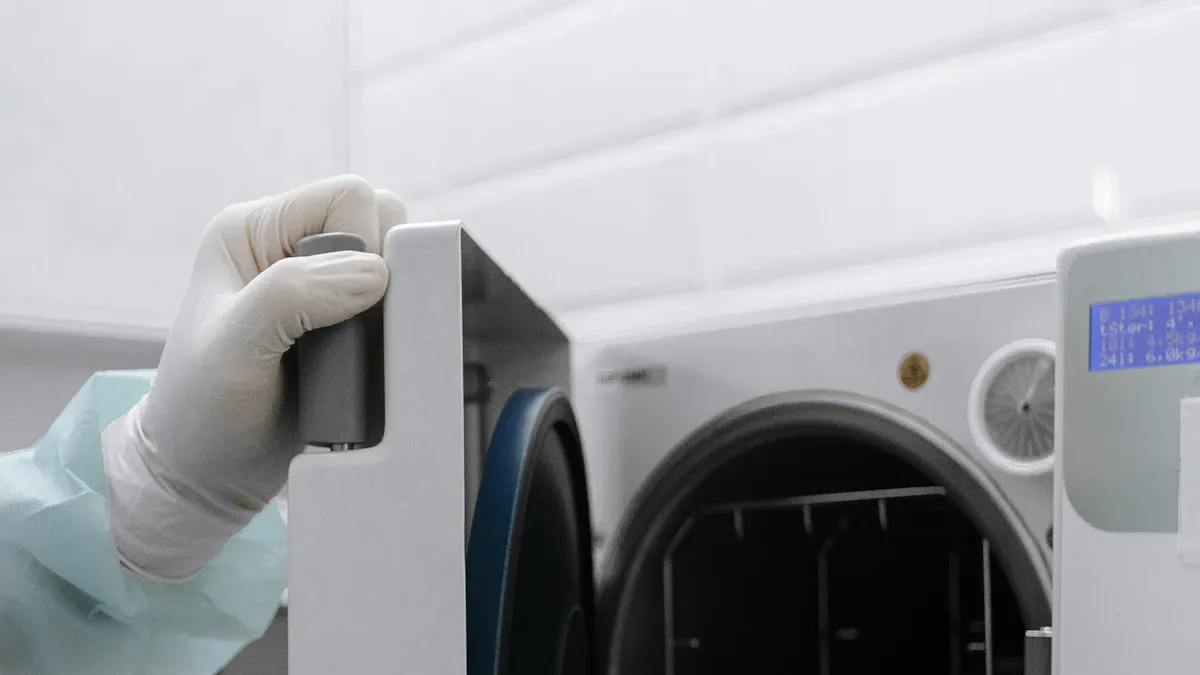
Sterilization and durability are critical for medical devices. You need solutions that ensure safety and reliability. TAC coating provides a protective layer that resists corrosion and bacterial growth. It strengthens devices against mechanical stress, helping them endure repeated sterilization cycles. This innovation improves biocompatibility and extends the lifespan of medical tools.
Key Takeaways
- TAC Coating stops medical tools from rusting and growing bacteria. It keeps them safe and reliable.
- This coating makes devices stronger. They can handle many cleanings without breaking down.
- TAC Coating helps tools last longer. It lowers costs and keeps patients safer.
Overview of TAC Coating
Definition and Key Properties
TAC Coating is a specialized protective layer designed to enhance the performance of medical devices. It acts as a barrier, shielding devices from external factors that can cause damage. This coating is known for its unique properties, such as high resistance to corrosion, excellent durability, and the ability to prevent bacterial growth. These features make it ideal for use in healthcare environments where cleanliness and reliability are essential.
The coating also offers biocompatibility, meaning it is safe to use with the human body. It does not cause adverse reactions when in contact with tissues or fluids. Additionally, TAC Coating can withstand extreme temperatures and harsh chemicals, making it compatible with various sterilization methods. Its ability to maintain these properties over time ensures that medical devices remain effective and safe for repeated use.
How TAC Coating Works in Medical Applications
TAC Coating works by forming a thin, uniform layer over the surface of medical devices. This layer acts as a shield, protecting the device from wear and tear caused by daily use. It also prevents moisture and chemicals from penetrating the surface, reducing the risk of corrosion. By creating a smooth, non-porous surface, the coating minimizes the chances of bacterial growth, which is crucial for maintaining hygiene.
In surgical instruments, TAC Coating ensures precision and reliability by preventing degradation. For implantable devices, it enhances compatibility with the body, reducing the risk of rejection. Diagnostic tools benefit from the coating’s durability, ensuring accurate performance over time. This versatility makes TAC Coating a valuable solution across various medical applications.
Sterilization Challenges and TAC Coating Solutions

Common Sterilization Methods and Their Impact
Sterilization is essential for maintaining the safety of medical devices. You may already know that common methods include steam sterilization, ethylene oxide (EtO) gas, and radiation. Each method has its own challenges. Steam sterilization uses high heat and moisture, which can weaken materials over time. EtO gas is effective but leaves chemical residues that can harm sensitive surfaces. Radiation, while powerful, can degrade certain polymers and coatings. These processes ensure cleanliness but often compromise the durability and functionality of medical devices.
TAC Coating’s Resistance to Corrosion and Bacterial Growth
TAC Coating provides a solution to these challenges. Its protective layer resists corrosion caused by moisture and harsh chemicals during sterilization. This resistance ensures that devices maintain their structural integrity. Additionally, the coating creates a smooth, non-porous surface that prevents bacterial growth. This feature is critical for reducing the risk of infections. By using TAC Coating, you can ensure that medical devices remain safe and hygienic even after repeated sterilization cycles.
Maintaining Device Integrity During Sterilization
Sterilization processes can cause wear and tear on medical devices. High temperatures, chemicals, and radiation can weaken materials or damage coatings. TAC Coating addresses this issue by forming a durable barrier that withstands these harsh conditions. It protects devices from cracking, peeling, or degrading. This durability ensures that your medical tools perform reliably over time. With TAC Coating, you can extend the lifespan of devices while maintaining their safety and effectiveness.
Durability Challenges and TAC Coating Benefits

Protection Against Wear and Tear
Medical devices face constant use, which can lead to wear and tear. Over time, this can reduce their performance and reliability. You need a solution that protects these tools from daily stress. TAC Coating provides a durable layer that shields devices from scratches, abrasions, and other physical damage. This protective barrier ensures that instruments maintain their precision and functionality, even after repeated use. By reducing surface damage, TAC Coating helps you keep your medical tools in excellent condition.
Corrosion Resistance in Harsh Environments
Exposure to harsh environments, such as sterilization chambers or bodily fluids, can cause corrosion in medical devices. Corrosion weakens materials and compromises safety. TAC Coating offers exceptional resistance to these conditions. It prevents moisture and chemicals from penetrating the surface, protecting the device from rust and degradation. This resistance ensures that your tools remain safe and effective, even in challenging environments. With TAC Coating, you can trust that your devices will perform reliably under any conditions.
Prolonging Device Lifespan and Ensuring Reliability
Replacing medical devices frequently can be costly and inconvenient. You need tools that last longer without losing their effectiveness. TAC Coating extends the lifespan of medical devices by preventing damage and maintaining their structural integrity. Its durable properties ensure that your instruments stay reliable over time. This longevity not only saves costs but also enhances patient safety by reducing the risk of device failure. TAC Coating helps you achieve better outcomes with fewer replacements.
Real-World Applications of TAC Coating
Surgical Instruments
Surgical instruments must perform with precision and reliability. You rely on these tools to function flawlessly during critical procedures. TAC Coating enhances their performance by providing a protective layer that resists corrosion and wear. This coating ensures that instruments maintain their sharpness and structural integrity, even after repeated sterilization cycles. The smooth surface created by the coating also reduces the risk of bacterial contamination, which is vital for maintaining a sterile environment. With TAC Coating, your surgical instruments stay durable and dependable, ensuring better outcomes for patients.
Implantable Devices
Implantable devices, such as pacemakers and orthopedic implants, require exceptional durability and biocompatibility. These devices remain inside the body for extended periods, making their reliability crucial. TAC Coating plays a key role in protecting these devices from corrosion caused by bodily fluids. It also enhances biocompatibility, reducing the risk of adverse reactions. By using TAC Coating, you ensure that implantable devices perform effectively and safely over their intended lifespan. This innovation contributes to improved patient safety and quality of life.
Diagnostic and Monitoring Equipment
Diagnostic and monitoring equipment, like blood glucose monitors and imaging devices, must deliver accurate results consistently. Frequent use and exposure to cleaning agents can degrade these tools over time. TAC Coating provides a durable barrier that protects sensitive components from wear and chemical damage. This ensures that your equipment remains reliable and precise, even after extensive use. By incorporating TAC Coating, you can extend the lifespan of diagnostic tools while maintaining their accuracy and performance.
TAC Coating transforms how you address sterilization and durability challenges in medical devices. Its resistance to corrosion, bacterial growth, and mechanical stress ensures safety and reliability. By improving device performance and meeting medical standards, it advances healthcare technology. This innovation enhances patient outcomes and supports long-term cost savings for providers.
FAQ
What makes TAC Coating different from other protective coatings?
TAC Coating offers superior resistance to corrosion, bacterial growth, and mechanical stress. Its biocompatibility and durability make it ideal for medical devices requiring repeated sterilization.
Can TAC Coating withstand all sterilization methods?
Yes, TAC Coating resists damage from steam, EtO gas, and radiation sterilization. It maintains its protective properties under extreme temperatures and harsh chemical exposure.
Tip: Always consult your device manufacturer to confirm compatibility with specific sterilization protocols.
Is TAC Coating safe for implantable devices?
Absolutely! TAC Coating is biocompatible, meaning it won’t cause adverse reactions when in contact with tissues or fluids. It ensures safety and reliability for long-term use inside the body.


